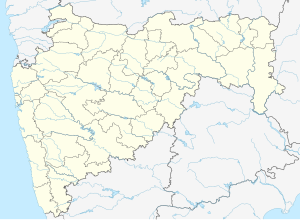Kalsubai
| Kalsubai | |
|---|---|

Kalsubai, highest peak in Maharashtra.
|
|
| Highest point | |
| Elevation | 1,646 m (5,400 ft) |
| Prominence | 1080 m |
| Listing | List of Indian states and territories by highest point |
| Coordinates | 19°36′04″N 73°42′33″E / 19.60111°N 73.70917°ECoordinates: 19°36′04″N 73°42′33″E / 19.60111°N 73.70917°E |
| Geography | |
| Location | Border of Igatpuri Taluka, Nashik district and Akole Taluka, Ahmednagar district, Maharashtra, India |
| Parent range | Western Ghats |
| Geology | |
| Age of rock | Cenozoic |
| Mountain type | Flood basalt |
| Type of rock | Basalt and Laterite |
| Climbing | |
| Easiest route | Hiking |
Kalsubai (Marathi: कळसूबाई शिखर) is a mountain (1646 meters) of the Western Ghats range located in the Indian state of Maharashtra. Its summit situated at an elevation of 5400 feet is the highest point in Maharashtra which earns it the much glorified title of the 'Everest of Maharashtra'.
The mountain range lies within the Kalsubai Harishchandragad Wild-life Sanctuary. It is visited throughout the year by avid trekkers, kalsubai temple devotees and wild-life enthusiasts alike.
The mountain range was formed by the same historical events that gave birth to the Western Ghats. Resting on the Deccan Plateau geologically identified as a large igneous province, it consists of solidified Flood basalt dating back to the Cenozoic era.
The peak along with the adjoining hills spans along a downward-slanting east to west axis eventually merging with the formidable escarpment of the western ghats at almost right angles.Along its length they form a natural boundary demarcating the Igatpuri Taluka, Nashik district at its north from the Akole Taluka, Ahmednagar district at its south.The mountain itself lies on the Deccan Plateau with its base at an elevation of 587 meters (1926 feet) above mean sea level.
The mountain along with adjoining hills forms an enormous catchment area for the Arthur Lake which it overlooks.
The mountain can be viewed, in its entirety, from Bari village located on its eastern side,about six km from Bhandardara. It can be reached by road, via Igatpuri on the Mumbai-Nasik route. Trains leaving from Mumbai provide an alternate mode of transport till Kasara railway station with connecting State transport buses, plying on the Akole-Kasara route, leading up to the base village. Private vehicles from Kasara provide yet another alternative to public transport.
...
Wikipedia

